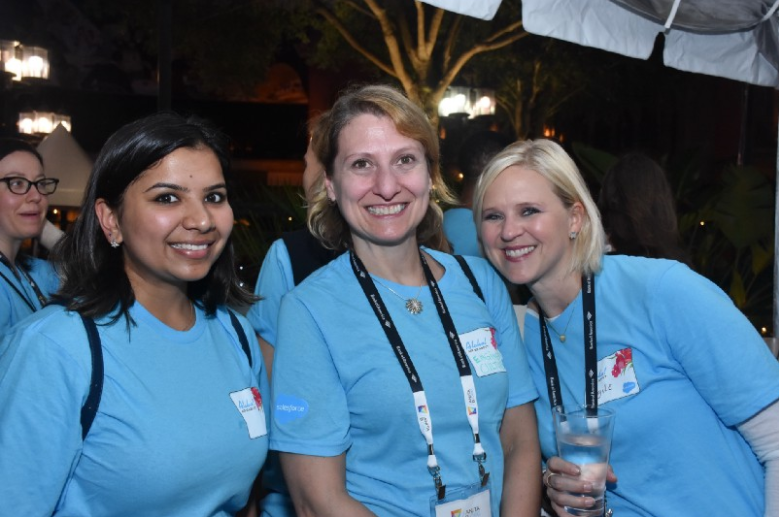It Takes a Village: Why Mentors Are Key for Keeping Women in Tech

This article by Andrea Leszek was featured in 100 Corporate Women Leaders in STEM, a publication by STEMconnector®.
Andrea Leszek is SVP of Technology & Products Services at Salesforce. She leads engineering enablement and engagement initiatives, including innovation programs, engineering training, employee recognition, diversity, technology marketing, and agile coaching. She is also responsible for customer-facing documentation, in-app help, and technology communications. She is a founding member of Salesforce’s Women in Technology network, and is passionate about increasing diversity in tech. She holds a B.S. and M.S. from the Massachusetts Institute of Technology.
Mentorship and a feeling of belonging are key factors for keeping women in technology. I learned this the hard way.
My high school chemistry and math teachers (both men) were my first technical mentors, and their encouragement prepared me for my college major — chemical engineering at MIT. The atmosphere of learning, technology, and science was exhilarating at MIT (still is!), but the isolation of being one of just a few women in my ChemE classes began to wear me down. On top of that, I was too young and inexperienced to understand the importance of the mentorship that my female ChemE professor offered. I ended up switching away from ChemE to focus on Linguistics and Cognitive Science, two departments that had more women and took a stronger role in mentoring their undergraduates. Unfortunately, my story is not unique for women in STEM — feeling isolated and lacking mentorship drives many women to take less technical roles or to drop out altogether.
As I’ve grown in my career since then, I’ve been fortunate to have great mentors who have pushed me to take on bigger roles and do things I didn’t think were possible. An early mentor in my career gave me the support and time to learn how to code. Another mentor helped me envision a bigger future role for myself, and another gave me the encouragement to take more risks. Having multiple mentors has been invaluable in my career.
Paying it forward is important to me. I regularly mentor women earlier in their career at Salesforce. I also volunteer as a mentor for Technovation, a world-wide challenge for middle-school and high-school girls to build mobile apps to solve a problem in their communities. I love to see the girls grow in confidence as they progress through the 12 week program. I’ve also been a program mentor with the Tech Women Program, a Department of State initiative for technical women from Africa, Central Asia, and the Middle East that pairs them with technical women mentors from Silicon Valley. Not only does the program promote peace and cultural understanding, but it gives all of the women (mentors and participants) a greater sense of belonging to a global community of technical women.
What I’ve learned from my experience as a mentor and a mentee is two-fold. First is that everyone can be a mentor because we all have something we can teach someone else no matter where you are in your career development. Second is to not be afraid to ask for help. Who knows where I’d be as a chemical engineer if I had asked for help or accepted the help offered to me back in college?
The positive news is that we’re at a turning point — more girls are becoming interested in STEM as computer science is taught in more schools and as programs like Technovation blossom. So, we need mentors not only to get girls into STEM fields but also to keep them there. Providing mentorship, experiences, and opportunities for girls can build their confidence and stretch their potential, but we need mentoring at every step of the way that goes deeper as they grow.
In addition, there is a growing awareness around the issues faced by women in technical fields and people are mindful of what I learned firsthand in college — that it can be difficult to feel like you belong when you’re in the vast minority. That’s why I started the Women in Technology (WIT) group at Salesforce. We have chapters in offices around the globe at this point! Some favorite events have been an outing to see Hidden Figures, a speed mentoring session, and an internal conference featuring lightning-style talks by Salesforce employees. People of all roles, departments and backgrounds have shown their support for WIT, and as a result it’s grown into a powerful community for our employees.
As part of my role at Salesforce, I lead an organization that is focused on creating the best, and most inclusive, engineering culture. We empower all of our employees with agile, innovation, learning, and development programs, and I hear from women all the time that they want to see senior leaders involved as mentors. In 2015, our team launched the Technology & Products Women’s Leadership program. The program originally focused on developing and mentoring senior women and it was so successful that we’ve expanded it globally and now serve women at even more levels, and work with male employees as well to engage them in creating a more inclusive workplace. It’s programs like this that have propelled Salesforce into the list of Fortune’s Best Workplaces for Women, and I couldn’t be prouder.
On a macro level, Salesforce emphasizes a four-pronged approach to building a path toward equality: equal pay, equal opportunity, equal education, and equal rights. In 2016, the company performed an audit of all employees’ salaries and provided pay adjustments as needed to close any pay gaps that existed. We performed another audit this year and plan to do so on an ongoing basis. This strong stance on equality makes me proud to work at Salesforce. I’m honored to be part of a company that supports women and is paving the way for the next generation of technical women!
Interested in joining Salesforce? Indicate your interest to their recruiting team.
